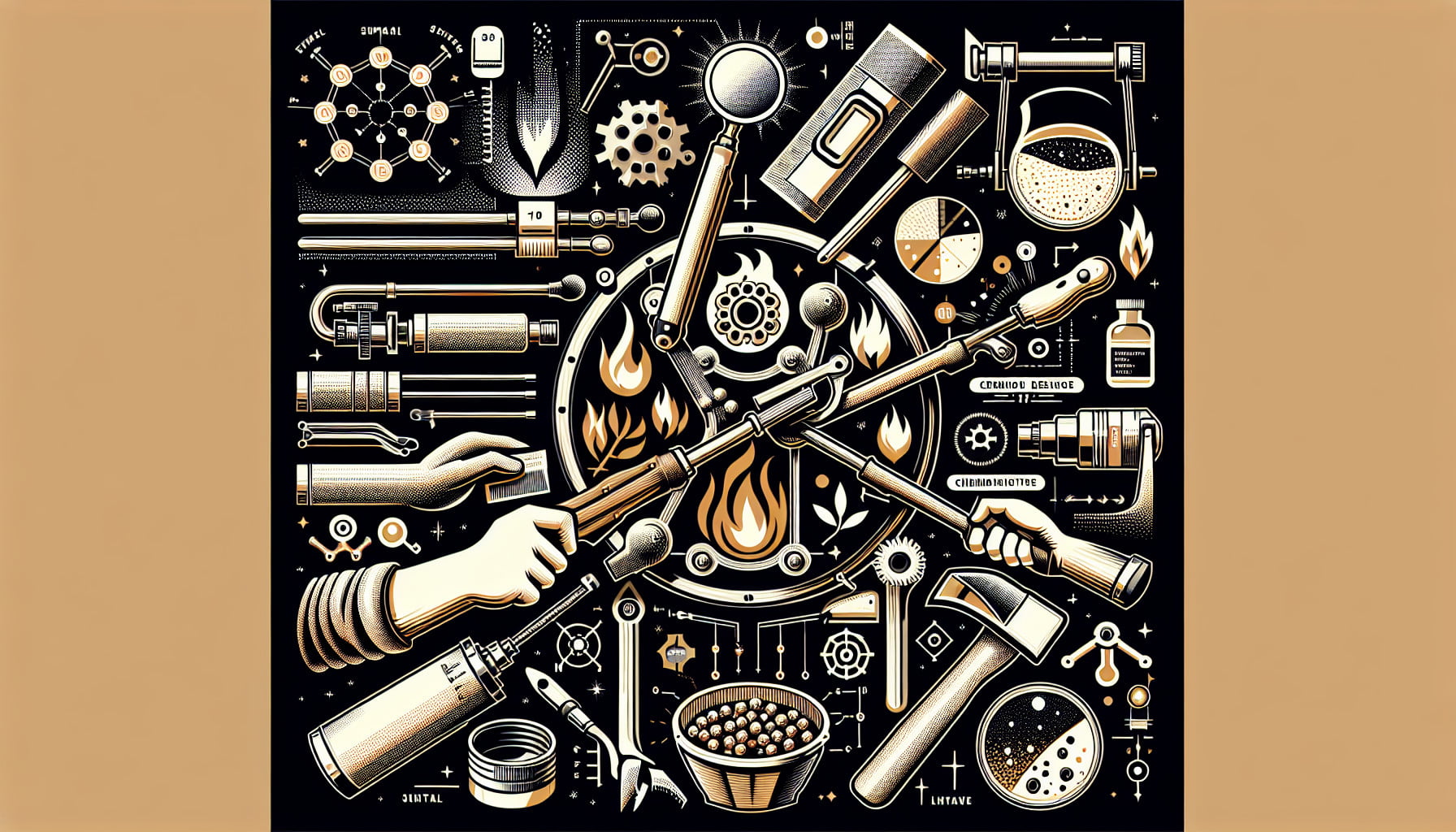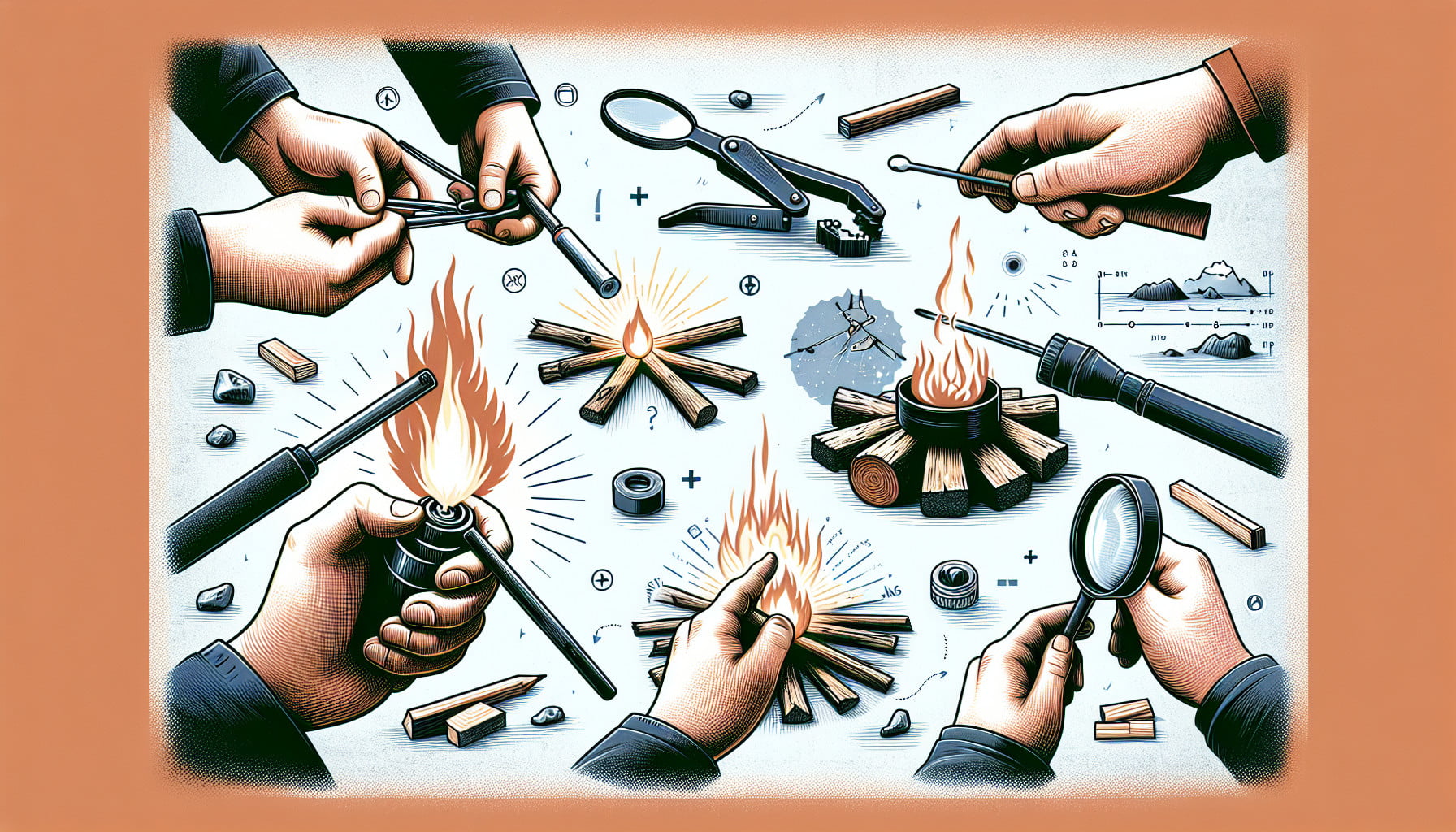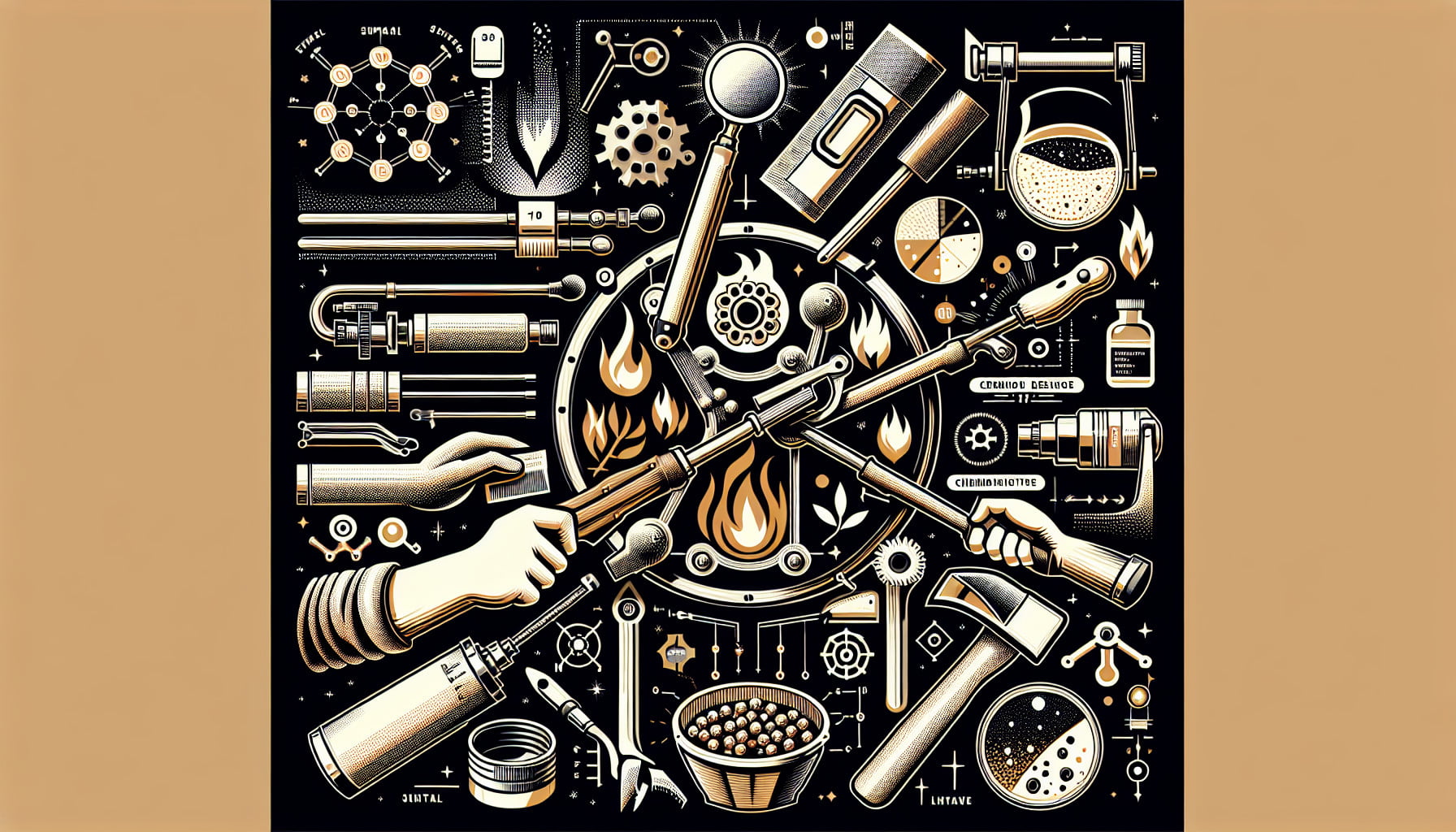In the great outdoors, the ability to start a fire without matches can be a valuable skill to have. Whether you find yourself in a survival situation or simply want to impress your friends on a camping trip, knowing the best techniques for starting a fire without matches is both practical and fun. From the ancient method of using friction to more modern approaches involving magnifying glasses and batteries, this article will explore a range of techniques that will leave you prepared and confident in your fire-starting abilities. Stay tuned as we uncover the secrets to successfully igniting a fire without the aid of matches.
Friction-Based Methods
Starting a fire without matches is a valuable skill to have, especially in emergency situations or when you’re out camping. One effective method is through friction. By using friction, you can create enough heat to ignite a fire. Here are three friction-based methods you can try:
Hand Drill
The hand drill method involves using a combination of a wooden baseboard and a spindle. To start, find a suitable wooden board and carve a small depression in the center. Next, make a spindle from a dry, straight stick with a flat tip. Place the spindle into the depression and begin rotating it rapidly between your palms. The friction generated by the rubbing motion will create heat, eventually producing an ember. Carefully transfer the ember to a tinder nest and blow gently to ignite it into flames.
Fire Plow
Another friction-based method is the fire plow. This technique requires a flat wooden baseboard and a wooden plow-like object. Begin by carving a groove down the length of the baseboard. Next, take the plow and rub it forcefully back and forth along the groove, pushing debris ahead of it. The friction between the plow and the baseboard will generate heat, eventually creating an ember. Transfer the ember to your tinder nest and blow gently to ignite a fire.
Fire Saw
The fire saw method is similar to the fire plow, but instead of using a plow-like object, you use a sawing motion to create friction. Start by carving a deep notch near one end of a wooden board. Then, take a dry stick and place it in the notch. Using a back-and-forth sawing motion, rapidly move the stick back and forth against the notch. The friction will generate heat, creating an ember. Transfer the ember to a tinder nest and blow gently to start your fire.
Spark-Based Methods
Spark-based methods rely on creating sparks that can ignite a fire. Here are three spark-based techniques you can try:
Flint and Steel
One of the oldest methods for starting a fire is using flint and steel. Start by holding a piece of flint in one hand and a steel striker in the other. Position the flint over your tinder nest and strike the steel against the flint, aiming to create sparks that fall onto the tinder. With a bit of practice and determination, the sparks will catch on the tinder, starting your fire.
Ferrocerium Rod
A ferrocerium rod, also known as a firesteel, is a modern and dependable method for producing sparks. To begin, gather your tinder nest and hold the ferrocerium rod in one hand. Using a knife or sharp edge, strike the rod forcefully, aiming to direct the sparks onto the tinder. Once the sparks land on the tinder, begin blowing gently to encourage the flames.
Battery and Steel Wool
If you have a battery and steel wool at your disposal, you can create sparks by connecting the battery terminals to the steel wool. Simply touch the positive and negative terminals of the battery to a piece of steel wool at the same time. The electrical current passing through the steel wool will generate sparks, which you can then transfer to the tinder nest to start a fire.

Chemical Reaction Methods
Chemical reaction methods involve combining specific substances to create a reaction that generates heat or fire. Here are three chemical reaction methods you can try:
Potassium Permanganate and Glycerin
When mixed together, potassium permanganate and glycerin create a chemical reaction that results in a fire-starting reaction. Start by creating a small pile of potassium permanganate and adding a drop or two of glycerin to it. The mixture will quickly produce flames, which you can transfer to your tinder nest to start a fire.
Sodium and Water
A chemical combination of sodium and water can produce an exothermic reaction, resulting in the creation of fire. This method should be handled with extreme caution due to the volatility of the reaction. Drop a small piece of sodium into a container of water, and the reaction will cause a release of hydrogen gas. Ignite the hydrogen gas to start your fire.
Hydrogen Peroxide and Potassium Permanganate
Mixing hydrogen peroxide and potassium permanganate together can result in a fire-starting reaction. Combine the two substances in a small container or directly on a non-flammable surface. The mixture will begin to bubble, generating heat that can ignite a fire. Transfer the flames to your tinder nest carefully.
Lens-Based Methods
In lens-based methods, the power of sunlight focused through a lens can ignite a fire. Here are three lens-based techniques you can try:
Magnifying Lens
Using a magnifying lens, like a magnifying glass or the lens from binoculars, you can focus sunlight onto a specific spot, generating enough heat to start a fire. Hold the lens at a suitable distance from your tinder nest and adjust the angle until you concentrate the sunlight onto a small area. Hold steady until you see smoke, and continue to focus the lens until the tinder ignites into flames.
Eyeglasses
If you have a pair of eyeglasses with convex lenses, you can use them as a fire-starting tool. Hold one lens close to your tinder nest and angle it to focus the sunlight through the lens onto a small area. As you adjust the angle, the concentrated sunlight will create heat, eventually igniting the tinder. Be patient and diligent until you achieve success.
Water-Filled Balloon
A water-filled balloon can act as a makeshift lens, allowing you to harness the power of sunlight. Fill a balloon with water and hold it above your tinder nest. Move the balloon around until you find the optimal position that focuses the sunlight onto a small area of the tinder. Hold the balloon steady until you see smoke, and continue to focus the sunlight until the tinder bursts into flames.

Electricity-Based Methods
Electricity-based methods utilize electrical energy to start a fire. Here are three electricity-based techniques you can try:
Car Battery and Steel Wool
If you have access to a car battery and a small piece of steel wool, you can create a fire by connecting the steel wool to the positive and negative terminals of the battery. Press the steel wool against the terminals simultaneously, and the electrical current passing through the steel wool will generate sparks and heat. Transfer the sparks to your tinder nest to ignite a fire.
9-Volt Battery and Steel Wool
Similar to the car battery method, a 9-volt battery can be used to create sparks with steel wool. Hold the steel wool against the positive and negative terminals of the battery, and the electrical current will generate sparks. Carefully transfer the sparks to your tinder nest to start your fire.
Piezoelectric Igniter
Many camping lighters come equipped with a piezoelectric igniter, which generates a spark when you press the ignition button. To start a fire using a piezoelectric igniter, hold the spark source near your tinder nest and press the button. The spark will ignite the tinder, and with some gentle blowing, you’ll soon have a crackling fire.
Chemical Ignition Methods
Chemical ignition methods involve using specific substances to ignite a fire. Here are two reliable chemical ignition methods:
Lighter Fluid
Using lighter fluid as a fire-starting aid can make the process quicker and more efficient. Saturate your tinder nest with a small amount of lighter fluid, ensuring that it is evenly distributed. Light the tinder nest with a spark source, such as a spark generated by flint and steel or a ferrocerium rod. The lighter fluid will catch fire and ignite your tinder easily.
Char Cloth
Char cloth is a lightweight and easily ignitable material that can be used to start a fire. To make char cloth, take a piece of 100% cotton fabric and cut it into small squares. Place the fabric in a metal tin and seal it tightly, leaving a small hole for gases to escape. Then, place the tin on a fire and heat it until the fabric stops smoking. Once cooled, the char cloth is ready to use. Place a piece of char cloth in your tinder nest and use a spark or ember to ignite it.
Fire Piston
A fire piston is a clever device that generates heat by compressing air rapidly, resulting in a fire-starting reaction.
Principle of Operation
Inside a fire piston, there is a small chamber with a plunger. When the plunger is pushed into the chamber quickly, it compresses the air inside, creating high heat due to the rapid increase in pressure.
Using a Fire Piston
To start a fire using a fire piston, place a small piece of tinder, such as char cloth, on the piston’s end. Insert the piston into the chamber and push it in quickly and forcefully. The air compression generates enough heat to ignite the tinder. Once ignited, transfer the burning tinder to your prepared fire bed to build a sustainable fire.
Bow Drill
The bow drill is an ancient fire-starting technique that relies on friction to create an ember. This method requires specific materials and proper technique.
Materials Needed
To perform the bow drill method, you will need five components: a fireboard, a spindle, a bow, a socket, and a tinder nest. The fireboard should be a dry, flat piece of wood, and the spindle can be made from a sturdy branch or stick. The bow can be any flexible branch or piece of wood, while the socket can be a stone, shell, or any smooth object. Lastly, prepare a tinder nest consisting of fine, dry materials like char cloth or feather sticks.
Steps to Start a Fire
- Prepare the fireboard by carving a small depression near one end. This will collect the wood dust created during the drilling process.
- Place the fireboard on the ground and kneel next to it, holding it firmly with your foot.
- Carve a pointy tip on one end of the spindle and place it on the fireboard, aligning it with the carved depression.
- Hold the bow in one hand and wrap the string around the spindle.
- Apply downward pressure on the spindle with the socket, ensuring it makes solid contact with the spindle.
- Begin sawing the bow back and forth, causing the spindle to rotate rapidly. Maintain a consistent and steady motion.
- As you continue to saw, the friction between the spindle and the fireboard will create wood dust and heat up the spot. Eventually, an ember will form.
- Once you see the ember, stop drilling and carefully transfer it to your tinder nest.
- Gently blow on the ember to encourage it to ignite the tinder materials.
- Gradually add more twigs and small sticks to build up the fire, ensuring proper airflow.
Coal Burning Technique
The coal burning technique is a method for starting a fire without matches that involves creating an ember and transporting it to a suitable location to build a fire.
Creating an Ember
To create an ember, you will need a fireboard, a spindle, a bow, and a socket, similar to the bow drill method. Follow the steps outlined in the bow drill section to generate an ember.
Transporting the Ember
Once you have an ember, carefully transfer it to a fire-safe container, such as a dry and hollowed-out piece of wood or a fireproof fabric pouch. The container will protect the ember from oxygen and prevent it from extinguishing. Carry the ember with care to your desired fire-starting location.
Building the Fire
At your fire-starting location, prepare a fire bed by clearing away any flammable materials and creating a small pit. Place your tinder nest in the pit and gently blow on the ember, coaxing it to ignite the tinder. Once the tinder ignites, gradually add small twigs and sticks to build the fire. Ensure proper airflow by positioning the larger pieces of wood in a teepee or log cabin formation. With patience and attention, your fire will grow and provide warmth and light.
Fire-Making Techniques in Different Environments
Starting a fire without matches can be challenging in various environmental conditions. Here are some tips for different environments:
Wet and Cold Environments
In wet and cold environments, finding dry tinder and kindling is crucial. Look for sheltered spots where natural dry materials like bark, fallen branches, or pine needles may have accumulated. Use the driest parts of the wood found, such as the inner part of dead branches or sticks. Additionally, utilizing spark-based methods or lens-based methods can be more effective in these conditions, as they do not rely on friction.
Dry and Hot Environments
In dry and hot environments, fire safety is paramount. Be mindful of the fire risk in the area and follow any local regulations or restrictions. Use fire pits or designated fire areas whenever possible. Ensure you have an adequate water source nearby to extinguish the fire completely once you’re done. In these conditions, using spark-based or chemical ignition methods can be safer and more efficient than friction-based methods.
High Altitude Environments
At high altitudes, the oxygen levels are lower, making it more challenging for fire to start and sustain. Ensuring proper ventilation is crucial for combustion. When using friction-based methods, consider exerting extra force to generate enough heat to produce an ember. Additionally, using chemical ignition methods or spark-based methods can be more reliable at high altitudes, as they rely less on oxygen availability.
By familiarizing yourself with different fire-starting techniques and practicing them beforehand, you can be well-prepared to start a fire without matches in various environments and situations. Remember to prioritize safety and respect any regulations or guidelines regarding fire use.

